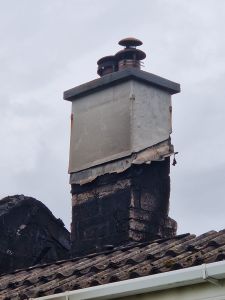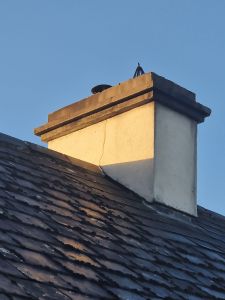Home Insurance Cover Chimney Damage?
Does Home Insurance Cover Chimney Damage? The answer to this question very much depends on what caused the damage to your chimney.
On average, the Irish Fire Services are called out to 2,000 domestic chimney fires every year. Click here for the National Fire Statistics
Throughout the year, our chimney damage insurance assessors are frequently contacted and asked the following questions;
- I had a chimney fire and it cracked my chimney, is this covered on home insurance?
- Will homeowners insurance cover cracked chimney liner?
- Does homeowners insurance cover chimney repair?
- Will insurance cover chimney repair cost?
- Am I covered for chimney lightning damage?
CHIMNEY DAMAGE HOME INSURANCE QUESTIONS CAN STEM FROM A VARIETY OF ISSUES:

Chimney Fire Home Insurance Claim.
- Sand falling down the chimney or into the fireplace
- Brown staining on chimney breast walls or ceilings.
- Damp stains on chimney breast wall of a bedroom, evident where paint may be flaking or signs of dampness
- Water coming down chimney
- Black staining coming the blockwork in your attic
- Cracks on my chimney stack
- Cracks on my wall above the stove
If you need to get chimney fire damage covered through your home insurance, a couple of items will be required by your insurance company first.
- A Fire Brigade Invoice (if available, but not essential)
- A Chimney CCTV Survey clearly illustrating damage to your chimney flue liners.
Essentially, your insurer will need confirmation that any damage to your chimney is a direct result of one of the insured perils within your home insurance policy.
A typical home insurance policy will cover your chimney for Fire Damage, Storm Damage or Lightning Damage.
If your chimney damage is a result of “wear & tear”, “old damage”, “a gradually occurring cause”, “faulty workmanship” or “faulty materials”, these are common exclusions within a home insurance policy.
There are 2 Types of Chimney Fires
If you have ever had a chimney fire, you will know it is not a pleasant experience. From the cracking, banging and rattling in your chimney to black smoke pouring from your fireplace, it can be a frightening & costly experience.
Did you know, there are two types of chimney fires (both of which can cause major damage to your chimney.
-
A Free Burning Chimney Fire –
These are fires that are very obvious and visible. They can sound like you have a freight train running through your chimney. The fire can be a roaring blaze of flames and can have smoke billowing from your chimney stack.
-
A Slow Burning Chimney Fire –
These can be quieter and less obvious, but equally as dangerous. The homeowner may not even know that this chimney fire is happening. These fires burn slowly at high temperatures. Visibly, not as dramatic as a “Free Burning Chimney Fire”, but can cause just as much damage!
Calling 999 and having the Fire Brigade attend is often the best and safest response to an active chimney fire. The call out fee is most likely covered by your home insurance policy.
What to do after a Chimney Fire
It is advised that you have your chimney checked after such an event. Calling one of our experienced Loss Assessors will set your mind at ease. We can advise on the next steps with regards to making a home insurance claim for chimney.
Water coming through Chimney.
Visible cracking on top of the chimney, around the chimney pot may be the reason behind that leak in your chimney. A quick fix solution is to seal over the top of the stack, but that does not solve the issue of the water already inside. Moisture trapped within the chimney stack cannot get out so will eventually seep through the walls causing a leak.
Water may also be penetrating due to the lack of an anti rain cowl on the chimney pot.

cracked chimney
In times of the Celtic Tiger, stoves were the new must have in home accessory. the heat output is amazing, stoves were – in most cases – attached to the original 8 inch clay flue liner. lay liners were installed when the property was originally built. They were only designed for the heat output from an open fire.
As the stove burns at a much higher intensity than an open fire, this causes the standard flue liner to crack and shatter.
Stove manufacturers recommend a 5/6 inch steel or flexi flu liner in order to cope with the heat output. The benefits of which are:
Stove will burn more efficiently as they were designed to fit the smaller flue liner
Steel/Flexi liners were designed to take the heat output given by a stove
Chances of flue damage are greatly reduced
According to drufire.com ‘A fireplace insert provides more heat and more efficiency. That difference in output is significant: an open fire has an output of around 10%, while a fireplace insert has an output of 65%. This means that with a fireplace insert you need considerably less wood to comfortably heat a room than with an open fire’
Prevention is better than cure.
We are all familiar with the phrase prevention is better than cure – in this case ‘a clean chimney is better than a dirty fire’!! All chimneys – no matter if they are rigid steel, flexi flu or clay liners – require essential maintenance by way of sweeping/cleaning.
Insurance companies (mainly UK providers in the Irish market) have been known to reject an insurance claim or withhold a claims payout without proof of your chimney being cleaned by a registered chimney sweep.
Please remember to check your fire and carbon monoxide alarms regularly.
